IT’S been all about Bersih 3.0 this past week. Stories, tweets, photographs and videos have been shared. Fingers pointed, heroes praised, villains demonised. Yet, important questions remain despite the numerous articles in the traditional media. For instance, if there were numerous reports in the traditional media about one of the most historic moments in Malaysia’s political development, why is it that anybody reading just the national print media would be left with an incomplete picture?
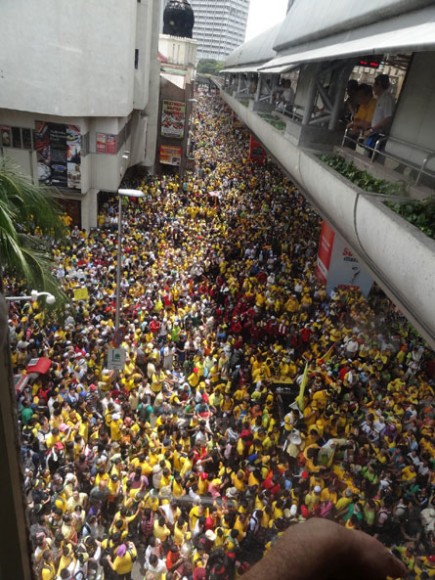
Did the Malaysian press perform its role in informing the public of Bersih 3.0 and the events surrounding the movement? And what can we surmise about the state of the Malaysian media from its coverage of the 28 April 2012 Bersih 3.0 rally?
Misleading numbers
One major fact about the demonstration calling for free and fair elections was that it was huge. Looking at rally pictures, it was likely the biggest demonstration in Malaysian history. Bersih 2.0 organisers estimate about 300,000 joined the rally in Kuala Lumpur, with thousands of others gathering in various other local and foreign cities. While it’s hard to be exact about these numbers, and the rally organisers would have a vested interest in enlarging them, anecdotal and visual evidence tell us that the crowd was impressively huge and cohesive.
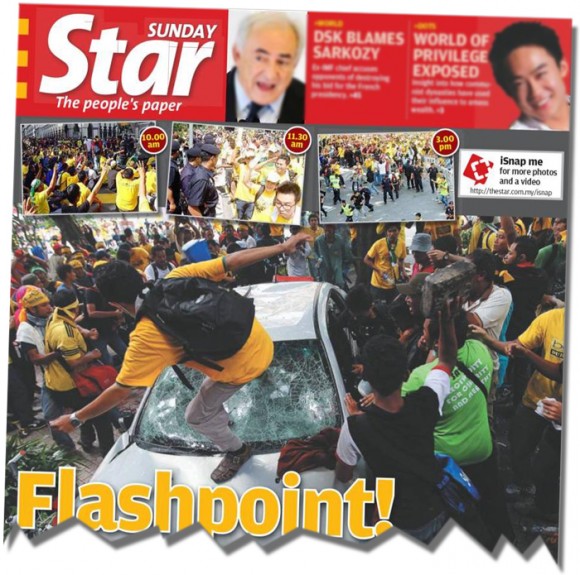 Yet, amazingly, the morning after the rally, The Star was silent on how many had turned up. Although it dedicated five full pages to Bersih 3.0 reports, the national paper made no mention or estimate of the historical numbers of citizens who demonstrated.
Yet, amazingly, the morning after the rally, The Star was silent on how many had turned up. Although it dedicated five full pages to Bersih 3.0 reports, the national paper made no mention or estimate of the historical numbers of citizens who demonstrated.
The New Straits Times and Utusan Malaysia chose to quote Home Minister Datuk Seri Hishammuddin Hussein, who put the number at 20,000. This number is just implausible if the visual evidence from various parts of the city is anything to go by. This only leads us to wonder whether our politicians – and a senior cabinet minister, no less – and some national newspapers are being deliberately obtuse on just how much support Bersih garnered.
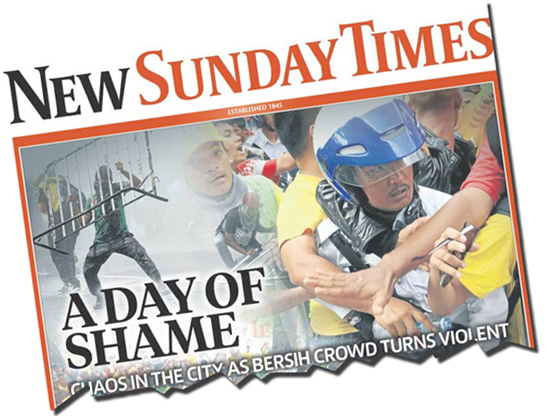
To theSun’s credit, it published a more believable number, estimating the crowd to be around 80,000.
Violence
![]() Against journalists
Against journalists
This was a first – journalists on duty in Malaysia being systematically attacked by police. A joint statement by media non-governmental organisations counted at least a dozen such instances. Police not only roughed up working journalists – some more seriously than others – they also threatened arrest and in some instances detained them. On top of that, they also reportedly confiscated cameras and memory cards or demanded for photographs to be deleted.
And yet, neither The Star nor the New Straits Times reported on these targeted attacks on 29 April 2012. Two of the 12 instances of police attacks on the media involved photojournalists from The Star, but the paper only ran an article about it two days after the event. The story was buried on page 10.
In a 29 April 2012 article headlined Petugas media turut jadi mangsa penyokong Bersih, Utusan Malaysia reported on the protesters’ attack of Al-Hijrah journalist Mohd Azri Mohd Salleh. The article also included a photograph of The Malay Mail photojournalist Muhamad Arif Kartono, who was assaulted.
Muhamad Arif, however, was beaten up by several police officers, not the demonstrators. And yet, in reporting about his experience in the report’s last paragraph, Utusan Malaysia makes no mention that Muhamad Arif was attacked by the police. This is curious since the information was already publicly available when The Malay Mail managing editor Terence Fernandez tweeted about it at 4.24pm on 28 Apr 2012. And indeed, by leaving out this critical bit of information, it would seem that Muhamad Arif suffered at the hands of demonstrators just like Mohd Azri did.

Again to its credit, theSun prominently featured police attacks on journalists. An assault against its journalist Mohd Radzi Abdul Razak front-paged the newspaper on Monday, 30 Apr 2012 (theSun does not publish on weekends). The report detailed the assault that was unprovoked, and which continued even after Radzi had identified himself as a journalist. The paper also carried the media NGOs’ joint statement and the National Union of Journalists’ statement on page two.
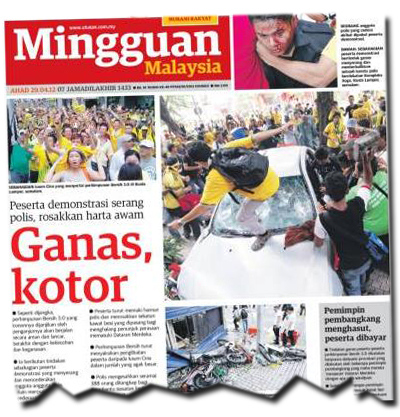
![]() Against protesters
Against protesters
Just as in Bersih 2.0, allegations of police brutality against protesters at Bersih 3.0 have arisen. Protesters have spoken of police beating, kicking, slapping and taunting them, and making them remove their Bersih T-shirts.
On 29 April, New Straits Times and The Star reported that 63 protesters and two police officers sought treatment at Kuala Lumpur Hospital. The Star reported that 63 were treated for trauma created by injuries, while New Straits Times said seven were warded for breathing difficulties and fatigue. There were, however, no accompanying reports on how protesters sustained these injuries.
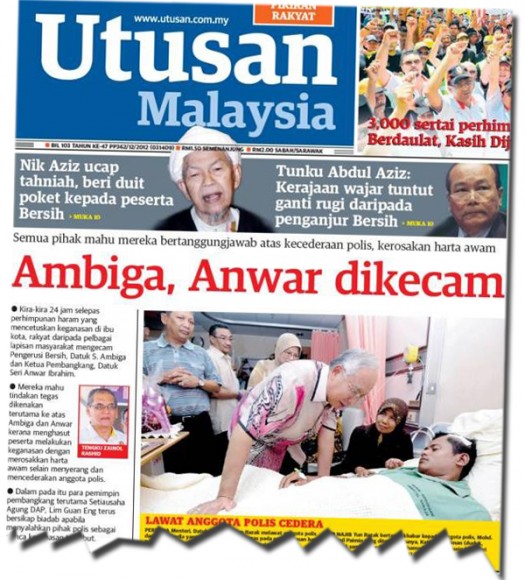
![]() Against police
Against police
Bersih 3.0 saw protesters throwing objects at police vehicles, a police car being overturned, and police suffering injuries.
Contrary to police violence against the mostly peaceful demonstrators, violence against police was well-documented in The Star, New Straits Times and Utusan Malaysia. The photo of injured officer, Constable Mohd Kamil Paimin, appeared on the front pages of all three newspapers on 30 April 2012.
What is the impact of foregrounding those who suffered violence at the hands of protesters and downplaying, even blacking out, the victims of police violence? By doing so, the media send a loud message about what kind of violence is deemed permissible and what is reprehensible.
Big picture
Important questions also need to be asked and answered following Bersih 3.0. They are as follows:
![]() On the right to peaceful assembly
On the right to peaceful assembly
Should this right be subjugated to the discretion of the Kuala Lumpur mayor under a local government by-law? Should the mayor have the right to allow a large corporation like Nestle to utilise Dataran Merdeka, while denying Malaysian citizens, who want free and fair elections, its use?
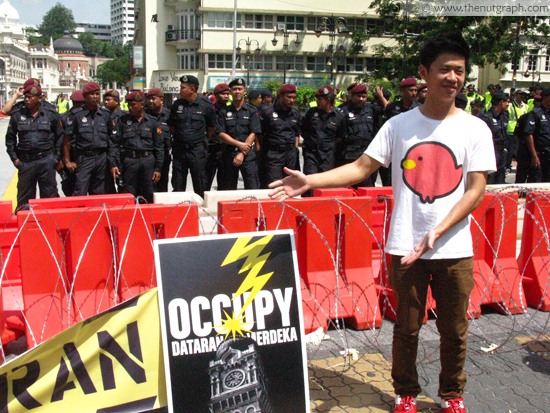
![]() On police action
On police action
When can police fire tear gas at a crowd? Did their actions endanger the lives of protesters that day by boxing them in? Were they justified in firing tear gas once protesters breached the barricades up on Jalan Raja? Is it time to revive discussions on the Independent Police Complaints and Misconduct Commission?
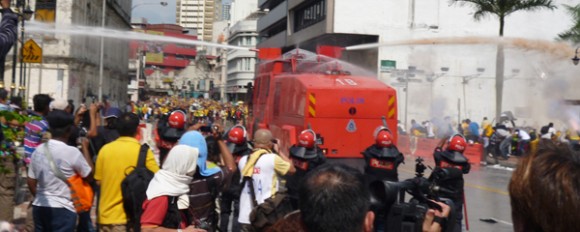
![]() On violent protesters
On violent protesters
How did this occur in what was mostly a peaceful rally? Who were they? Will they be charged?
![]() On elections
On elections
Will the government take heed of the scores of thousands who protested on 28 April? Will further changes be made to the electoral system to make it more transparent and fair?
These are critical issues the media needs to ask. And by virtue of the fact that the media is the fourth estate, it should be leading and framing these discussions in the public’s interest. Sadly, many of the print media have failed to play this role.
Devious and dishonest
The limitations of the Malaysian print media are well known. Most are owned by political parties and stand to lose their licence if they displease the Home Ministry, amendments to the Printing Presses and Publications Act notwithstanding.
But to hide the massive numbers at Bersih 3.0, omit or downplay police brutality against journalists and the public, and refuse to ask important questions after the event is just devious and dishonest. It makes one wonder how much pressure newsrooms must be under at the moment, whether from the Home Ministry or political owners.
Sure, a newspaper can have ideological or political leanings. After the 2011 London riots, for example, The Guardian ran features on how poverty, inequalities and societal dysfunction could have contributed to the riots, perhaps reflecting their traditionally left-leaning views. But these views did not stop the newspaper from reporting on the extent of the mob’s violence and looting or lead the national paper to hide facts in order to cast the mob in a sympathetic light.
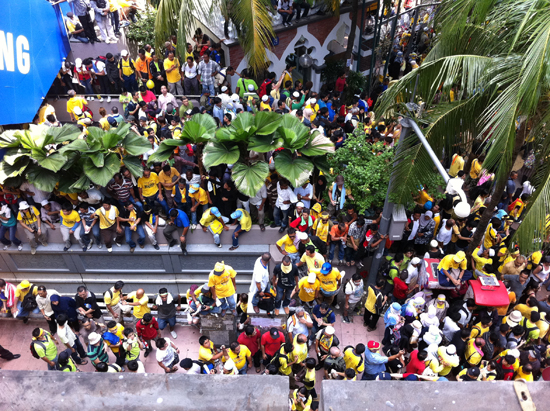
One newspaper
In Malaysia, someone would probably have to read four newspapers of different languages, three online news sites and two blogs, and scan their Twitter feed to get a comprehensive idea of what happened during Bersih 3.0. And with the factual distortions demonstrated by the New Straits Times and Astro’s censorship of BBC and Al-Jazeera reports on Bersih 3.0, can any Malaysian trust what they read, watch and listen to in the traditional print and broadcast media in Malaysia?
This makes a mockery of the Barisan Nasional government’s so-called press reforms and demonstrates how badly the national media has failed Malaysians. And if the national media are already skewing the news now, imagine how much worse it will be when the elections are called. This brings us back to Bersih 2.0 and its demand for free and fair access to the media as one of the conditions that will ensure a clean election. With the evidence in hand, it’s hard not to support the movement’s demands. ![]()
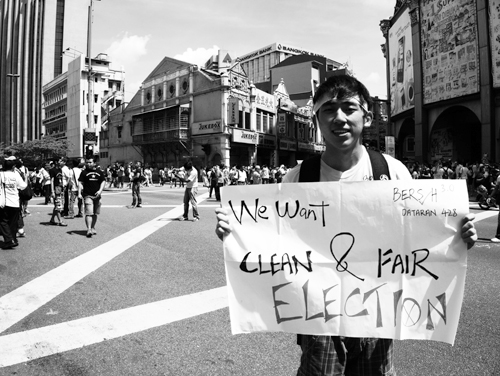
Ding Jo-Ann is the media monitor at the Centre for Independent Journalism, Malaysia and has monitored media coverage of both Bersih 2.0 and Bersih 3.0. She is also the co-author of CIJ’s Freedom of Expression 2011 report, which will be launched this month.


Xavier Gomez says
Media engineering of the local mainstream media revealed a contagion that has long beset it: it is a subservient instutionalised captives of the government. It may take a ‘Bersih’ (cleansing) of its editorial cronies and spin doctors if the people of Malaysia are to consider them of any worth or integrity. […]
The girl in the red Ferrari says
Someone should print out this article and put it at all homes in rural areas, and areas where access to the Internet is limited and the voting rakyat dont know the true picture of what is happening.
Bersih3.0 Participant says
To put some perspective on the number of Bersih 3.0 participants, I personally learnt from those riding the LRT from Kelana Jaya at about 9am that the coaches were packed to the brim and the situation was still same when I was on the train at about 11 am. A rough estimate of the number of people using the LRT from Kelana Jaya alone would indicate >20,000+ people(capacity /hr is about 10K per direction). If one multiplies this by 8 (2 each for Putra and STAR, and 4 for commuter trains. See this map http://www.putralrt.com.my), it could easily add up to >150k people for those using these trains to get into the city.
Azeem says
You’re being biased as well! While I can appreciate the government is being biased using the police and mainstream media, Bersih is biased as well. We can tell Ambiga clearly exaggerated the evidence after her debate against [Khairy Jamaluddin]. While i can agree there were 300,000 people, how many of them knew the facts were being exaggerated? Of course anyone would support a ‘free and fair election’ struggle. But if the facts have been exaggerated, what is there to really fight for? There is only one explanation, Bersih was an opposition struggle only disguised in yellow. which is why the majority of Bersih supporters are also supporters of the opposition.
Yeo Kien Kiong says
I am glad that your comment came into light. For a much lighter side, if you do not support “BERSIH 3.0”, there must be a lot of reasons that you support the corruption of the mass media?
eric says
Malaysia is a joke. The horribly biased media […], people have to suffer only to do a protest. Let this show the world that this is a govt of iron fist. […]
ramasamy says
300,000 against (your guess only lah) but a silent and major majority is 28 million. Nothing great to shout about, Bersih 3. Nothing. Just a pair of jokers head the rally and the others jokers just follow. Nothing.
JW Tan says
And it’s taken a lot of work and effort to get to this stage. I’d recommend this quote (translated) by Martin Niemoller, about the Nazis and the Holocaust:
First they came for the communists,
and I didn’t speak out because I wasn’t a communist.
Then they came for the trade unionists,
and I didn’t speak out because I wasn’t a trade unionist.
Then they came for the Jews,
and I didn’t speak out because I wasn’t a Jew.
Then they came for me
and there was no one left to speak out for me.
Political apathy is a bad thing. And unfortunately, it’s a habit Malaysians seem to have picked up over the years. It plays right into the hands of BN, who prefer sheep over people as voters.
So yes, it is a good thing to have 300,000 people questioning and speaking out. We need to work on the remaining 28 million. They may disagree, but I think no reasonable person could object to strengthening our institutions so that we can avoid ending up with no one else to speak out for us.
John says
Mr Ramasamy, I respect your view, but I think it is also a refusal to face reality. […] It is people like you that we need to reach out to. The battle has begun.